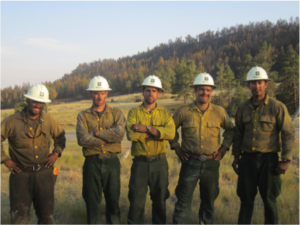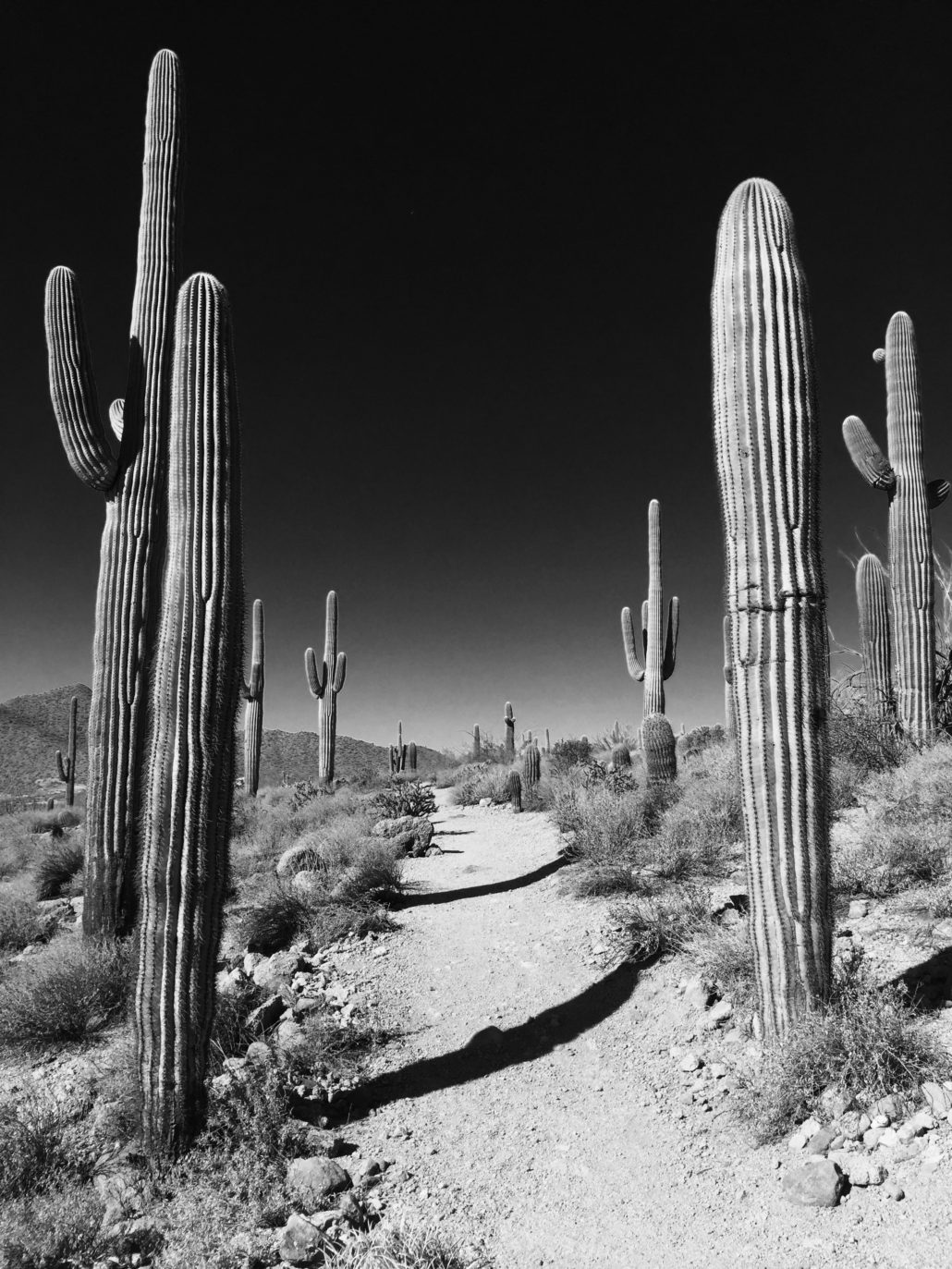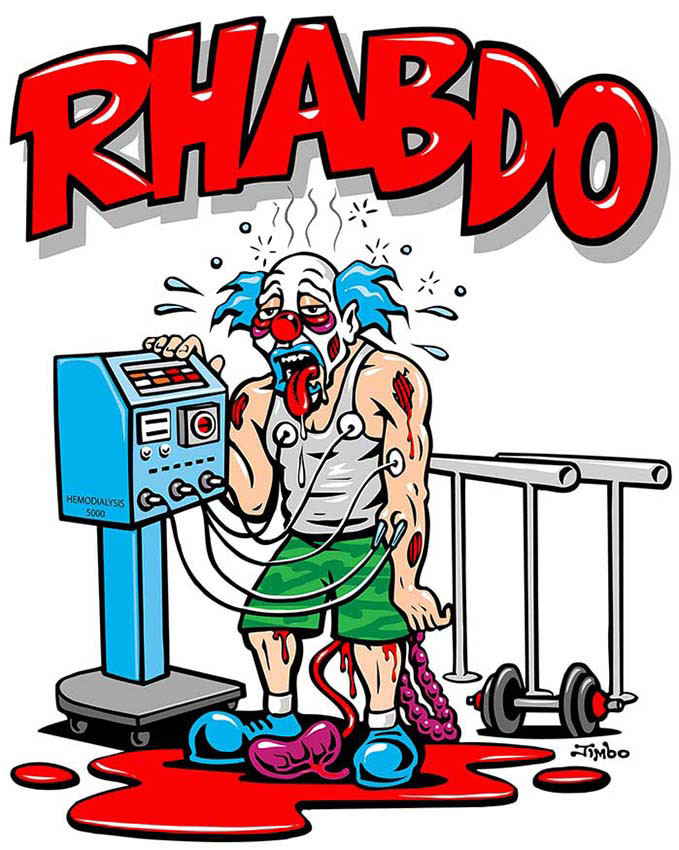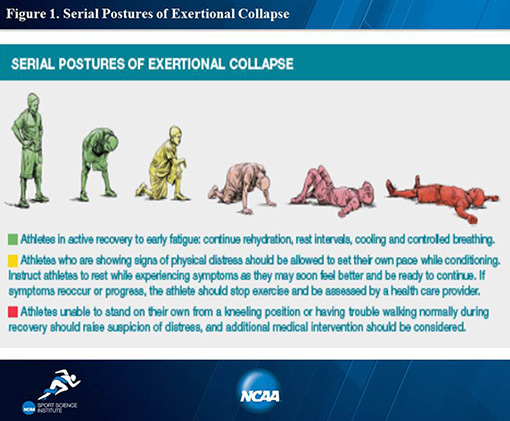As many crews begin their season ramp up with critical refresher training, and PT tests, it’s worth taking “Six Minutes for Safety” to learn more about this nasty thing called Rhabdomyolysis, or “Rhabdo” for short.
Last year we saw a disturbing spike in firefighters suffering over-exertion injuries. Specifically, over a two-month period in 2016, we saw seven reported cases of Rhabdo during PT tests, Pack tests, and crew PT. More troubling, four of those cases occurred over a four day period. Four cases were reported in May, and three were reported in June.
[column]Who was Impacted?
- Five Handcrew members
- Three type 1 crew members
- Two type 2 crew members
- One helitack crew member
- One engine crew member
[/column]
[column]Where Did the Incidents Occur?
- California (2)
- Oregon
- Idaho
- Nevada
- South Dakota
- Wyoming[/column]
Takeaway: Rhabdo is not limited to one specific group of firefighters (all are at risk). Additionally, geography matters little. The cases were spread across the west about as evenly as possible.
What the heck Is “Rhabdo”?
Rhabdo occurs when skeletal muscle tissues are degraded to the point of disintegration, and begin to leech into your bloodstream. As your damaged muscle tissues breakdown, one of the by-products is a protein called myoglobin. As you’ll no doubt remember from your high school biology class, the kidney is working 24/7 to filter your blood. All the gunk it filters out is turned into urine. Which is why you pee. In a twenty-hour period, the average kidneys will filter around 120-150 quarts of blood and produce one to two quarts of urine. Well, as your muscle tissue is breaking down, and these myoglobins are entering your blood stream, you have a problem. Myoglobin is like Kryptonite to a kidney. The protein can cause some serious damage to the kidney, often times irreversible damage.
Here’s what makes Rhabdo so nasty – you literally piss away your muscle tissue. it’s disgusting. And the long-term effects can be extremely serious, ranging from kidney failure and partial paralysis, and sadly, even death.
Rhabdo is a serious threat to the health and safety of all wildland firefighters, and the most dangerous time is NOW – at the beginning of the season.
What Causes It?
WebMd has a great run-down of the various causes of Rhabdo, but the most likely causes of Rhabdo in wildland firefighters are:
- [highlight]Extreme muscle strain, especially in someone who is an untrained athlete; this can happen in elite athletes, too, and it can be more dangerous if there is more muscle mass to break down. Some use cbd cream to help soothe this, but even so people should try to avoid hurting themselves like this.[/highlight]
- [highlight]A very high body temperature (hyperthermia) or heat stroke[/highlight]
So, participating in a grueling PT or training in hot environments without proper pre-training exposure. Heat stroke can be a major factor for season firefighters arriving from out-of-state, who have not allotted enough time to acclimate to their new environment. Think a new crew member from Montana who arrived the night before his first day on a crew in Arizona.
How to identify Rhabdo Symptoms
While Rhabdo’s symptoms can be unique and varied, the “classic triad” of symptoms are, according to WebMD, the following:
- Muscle Pain in shoulders, thighs, or back
- Muscle weakness and difficulty moving limbs
- Tea-colored urine
Here are some additional symptoms that may be present:
- Abdominal pain
- Nausea or vomiting
- Fever, rapid heart rate
- Confusion, dehydration, fever, or lack of consciousness
How Is Rhabdo Treated?
First off, the person needs to be hospitalized. This isn’t one of those things where you walk the firefighter over to some shade, sit him down, and give him a gatorade and some Advil and tell him to relax. The person’s organs are beginning to shut down and without timely medical intervention, the firefighter is at serious risk. Once at the hospital, the firefighter will be given IVs of fluid to help maintain regular production of urine and prevent the kidneys from failing. And, depending on severity the case, treatment might occur in the ICU, and / or may even require surgery. The good news is that if caught early, and treated appropriately, full-recovery is quite likely.
How to Prevent / Avoid It?
- The NCAA provides a simple mantra: Avoid Too Much, Too Soon, Too Fast
- Mental Stress has an impact. Anxiety has been linked to the onset of Rhabdo symptoms. As anyone who’s ever been the new guy on a crew can attest to, the first day, and the ensuing weeks, can be stressful. Combining physical with mental stress can exacerbate both, and lead to a heightened risk of Rhabdo. Beware of the mindset that your rookies are coming in with. They may want to look at trying some different ways of relaxing themselves mentally to help curb stress. Medical marijuana has previously been used to calm racing minds down, however, the law is different in each state for taking this type of alternative remedy and must be researched first, for example, missouri marijuana laws may be different to Californian marijuana laws. Depending on if cannabis is available for recreational or medical use will affect the availability of the product. If you live in an area that only allows medical use, reading up on qualifying conditions (https://ohdispensaries.com/ohio-marijuana-qualifying-conditions/) will help you get the assistance you require.
- Maintain proper hydration
- Provide recovery opportunities. If firefighters are woozy, wobbly, taking knees, and struggling, it might be worth a break. If firefighters are flopping on to their backs, and struggling to hold themselves upright, or in a kneeling position look out. That’s a problem. The NCAA provides a great chart showing the spectrum of recovery.
How to Help Your Fellow Crew Members
- Awareness. Familiarize yourself with the symptoms of Rhabdo. Have an action plan in place if someone begins to show symptoms. Better to have a false positive than a false negative. Keep these two printouts handy in the event that you need to take a crew member to seek medical treatment.
- Call it out. We call out snags, rocks, and tripping hazards because they pose a danger to the individual firefighter AND to the crew. Same thing with medical issues. Like so many illnesses, it’s difficult for a person afflicted by Rhabdo to self-diagnose. That’s why it’s critical for crew members to be vigilant in monitoring each other’s performance. If something is off – say something
Conclusion:
Regardless of whether you’re training in Wyoming or SoCal, Rhabdo is a serious danger faced by firefighters. And it should not be written off as something that only impacts the old firedogs, or those who show up for duty in poor shape. In fact, in January 2011, a ridiculously intense pre-season workout landed 13 University of Iowa football players in the hospital, one for Rhabdo. And earlier this year, in January, a member of the University of Oregon football team was hospitalized with Rhabdo following an off-season workout. Let’s be honest – college football player are in better shape than 99% of wildland firefighters. And they’re just as susceptible to Rhabdo.
Be safe out there, and take care of one another.
Additional Resources:
Wildland Fire Lessons Learned – Rhabdo Resources
Wildland Fire Lessons Learned – Podcast (Discussion on Rhabdo starts around the 5 minute mark)
New Year, New Mindset
With the New Year now upon us, most are starting to think about ways to scrape off the rust from these last few non-fire months. Whether you are new to fire or looking for ways to sharpen your athleticism, now is the perfect time to get moving. Make this season a safe and effective one by developing both the mental and physical fortitude needed for the job.
Firefighters as Tactical Athletes
Wildland firefighting has historically been a seasonal occupation, with young adrenaline-seeking men and women eager to make a year’s worth of wages to help get through the winter months to pursue other jobs, schooling, and adventures. I have even read stories in the first half of the 20th century which tell tales of local rangers recruiting young drunken men from barstools to put in a few chains of line and help extinguish a blaze. Fast-forward to the present time and you would be hard-pressed to find the firefighter who isn’t regularly maintaining some level of physical fitness and aptitude, even in the off season. Thankfully, there are many top tips online to help keep those looking to attain a better level of physical fitness do so. Check some out here – http://www.st-ambrose.com/2020/11/02/top-rated-tips-for-fitness-success/.
Our knowledge of fire and human performance has vastly improved and it is crucial that we treat the profession with the respect that it deserves. Between 2003 and 2007 alone, there were approximately 1,300 fireline injuries reported (Department of Interior, 2015). Using fire reporting software could help keep track of fire department records like this. Even more staggering to see is the 440 men and women who have been killed in the line of duty since 1990 (NIFC, 2015). It is not appropriate nor respectful of those injured or killed throughout the history of the profession to show up to your crew out of shape and unprepared. There is ever-developing science and techniques at our disposal, but it depends on your mindset.
Wildland firefighters (seasonal and permanent) work a hard, dangerous, and oft-badass job which requires technical skill, a sharpened mind, and physical prowess. The Tactical Athlete has been described as one whose occupations requires “Personnel to develop general physical preparedness in addition to technical and tactical skills that are crucial in environments involving civil protection, grave physical danger, or rescue situations” (Scofield and Kardoni, 2015). There has never been a better time than now to start preparing to be mountain tough and fire ready.
Fitness: mental and physical
Here at Hotshot Fitness, we are motivated to help you fulfill your firefighting goals. It doesn’t matter if you are a salty veteran or a green rookie; we all have the capacity to improve. If you look up fitness in a dictionary, you will see it defined as “the quality of being suitable to fulfill a particular role or task”. The wildland firefighting environment requires firefighters to bring mental toughness and physical strength to work, every shift, every roll. Your success at being able to satisfy those demands determines your fitness. And that is 100% in your power to control.
You have the good-fortune of being in the middle of the off-season which means time for self-exploration. What are some of your goals for the upcoming year? Is it to pull your weight on a hotshot crew? How about exhibiting the physical strength and stamina to prove you belong on a saw team? It may even be that you are new to this world and are looking to simply pass the Pack Test and start your career in fire. The point is, there is no goal too small. You can pour over the articles on this site and find physical tips to get your ass in gear, however, it comes down to the action that you take.
Extreme Ownership is a term coined by and title of a book by retired Navy SEALs Jocko Willink and Leif Babin. I believe this book should be read anyone looking not only to lead others, but those wanting to take control of their own life. In it, the authors discuss how one must own everything about their decisions and actions and take responsibility for the outcome. As you kick your off-season training into high gear, we highly recommend that you adopt an “Extreme Ownership” mindset. Jocko also has an amazing podcast that we highly recommend checking out. He has also been featured on the Tim Ferriss podcast, and some of his advice made its way into Tim’s latest book, Tools of Titans (another HF highly-recommended read).
Your Off-Season To Do List:
- Read Extreme Ownership by Jocko Willink and Leif Babin
- Be Inspired
- Analyze your strengths and weaknesses.
- Set a goal (or goals)
- Prioritize and formulate a plan
- Execute. Execute. Execute
Use this new mindset to guide your choices, your training, and your performance as a tactical athlete in 2017.
Remember: Be S.M.A.R.T. With Goals. For some advice on goal-setting, check out some of our tips.

About the Author:
Anthony Harrell spent three years with the Ukonom Hotshots. His adventures in fire inspired him to pursue a career in Physical Therapy, and he recently graduated from the Doctor of Physical Therapy program at the University of California, San Francisco (UCSF) / San Francisco State University.
He lives in the San Francisco Bay Area. He has been a contributor to Hotshot Fitness since 2016.
Interested in writing for us? Check out our contributor guidelines for more information.

[pullquote]
“Developing an “attitude of gratitude” is one of the simplest ways to improve your satisfaction with life.” ~ Amy Morin
[/pullquote]
How many times have you woken up before dawn, cold and sore from a hard day of cutting line, and thought, “F this job. F this life. I’m done.”
And then proceeded to have a grumpy, miserable morning that led to an equally miserable afternoon and evening?
When I was on the Lassen Hotshots, and you hit that point where everything was awful, we called that “Jelly Fishing”. With your hands outstretched, and complaints spewing freely from your mouth, you could singlehandedly kill the crew’s morale.
That kind of negative energy is bad for you, and its bad for the crew.
So stop it. But how?
The answer is simple: Gratitude, my friends. But what exactly is gratitude? Properly defined, gratitude is “the quality of being thankful; readiness to show appreciation for and to return kindness.”
Researchers have documented the importance of gratitude on our overall happiness and well-being. People that take the time to focus on gratitude are healthier and mentally stronger.
I was shown this short film titled “Gratitude” by Louie Schwartzberg, and trust me, it will help refocus your priorities, and clarify your perspective. If I’m stressed or frustrated, I try to throw this on get some much needed perspective on what’s important.
Gratitude: The Short Film by Louie Schwartzberg from ecodads on Vimeo.
Obviously it’s not always convenient to just sit down and watch a six minute video. But the next time you’re out on the line, and you’re dreading the start of the next shift, reflect on this:
As a wildland firefighter, I am fortunate because:
- I am physically stronger than 99% of the population
- I am mentally strong enough to do a job that scares most people
- People dream about doing this job
- The work that I will do today might save a life
- I will see places today that very few people ever will. And they are beautiful.
- I will experience a clear sense of purpose. I know what my mission is today.
- The bond I have forged with my fellow firefighters is stronger than anything experienced by a civilian
- I love what I do.
Amy Morin and Tim Ferriss, among many others, are proponents of daily journaling with a focus on gratitude. You don’t need to be churning out pages fit for the New Yorker. All that is important is that you take some time to remind yourself of all that is positive in your life. The relatively small, yet powerful, act of shifting the focus away from the negative stressors and towards the positive aspects of your life can yield major gains in overall happiness. You choose which path you’re going to take. You choose whether or not you’re going to go down a path cluttered with negative emotions, or if you will travel down a path filled with positive emotions. Choose wisely.
So the next time you’re sitting in the buggy, driving out of fire camp, pull out your phone or a notebook and jot down some things that you’re thankful for. Make this a daily ritual, and you’ll be a happier, healthier hotshot. Guaranteed!
Interested in learning more about the importance of gratitude? Check out these books:
Amy Morin, LCSW “13 Things Mentally Strong People Don’t Do”
Tim Ferriss, “Tools of Titans: The Tactics, Routines, and Habits of Billionaires, Icons, and World-Class Performers“



